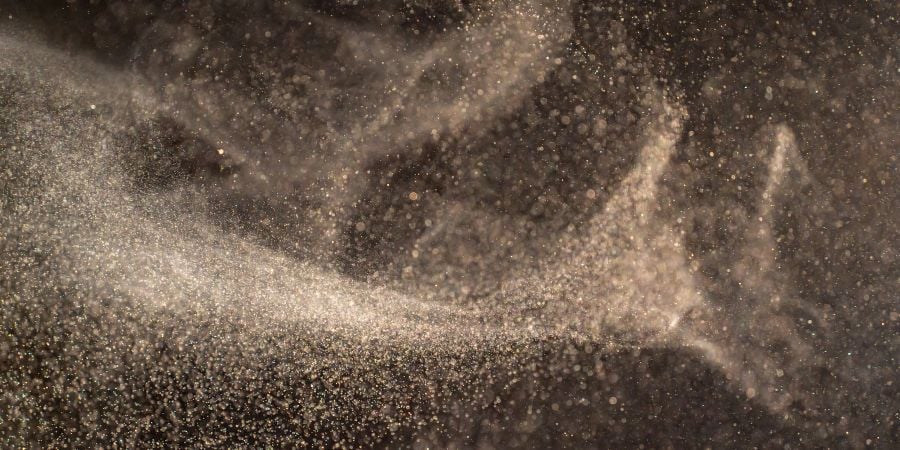Share this
HEPA Filtration: Combat High Levels of Contamination for Cleaner Air
by HEPACART on Dec 09, 2024

Breathing easy is a basic expectation that your patients and staff have when entering a healthcare facility, but it goes beyond comfort. Air contamination (or the lack thereof) can have a direct and profound impact on patient health, especially for those with weakened immune systems.
Invisible threats like indoor air contaminants such as mold, fungi, and viruses can lead to serious infections, prolonged hospital stays, and even life-threatening situations. As a facility manager, you're on the front lines of this battle, playing a crucial role in infection prevention through effective air quality management. Not only that, but you’re tasked with keeping up those high standards of safety and cleanliness over time. Is your facility prepared with the education and machinery to support you?
Keep reading to discover the impact of airborne contamination — but more importantly, how to mitigate the risks and keep your facility compliant through it all.
Understanding Airborne Pathogens and Their Impact on Healthcare
Airborne pathogens — microscopic bacteria, viruses, and fungi — are a significant threat in healthcare because of their ability to remain airborne for patients and staff to inhale them. Everyday activities like coughing, sneezing, or even talking can release these pathogens into the air, and the concentration of people in a medical facility makes this risk even more dangerous.
For instance, during construction or renovation projects within a hospital, spores from molds like Aspergillus can become airborne and infiltrate indoor spaces. Without effective air quality management, these spores can lead to serious infections among vulnerable patients. The Centers for Disease Control and Prevention (CDC) acknowledges that air contamination contributes to the spread of healthcare-associated infections (HAIs), and all of this points to the need for powerful air filtration to keep your facility safe, healthy, and compliant during both normal operations or disruptive construction work.
The Role of HEPA Filtration in Infection Control
High-efficiency particulate air (HEPA) filtration is proven to be one of the most effective methods for removing airborne contaminants in healthcare settings. Unlike other filters, HEPA filters capture particles as small as 0.3 microns with 99.97% efficiency. This means they can effectively trap harmful pathogens like Aspergillus spores and Mycobacterium tuberculosis.
HEPA filters work by forcing air through a fine mesh that traps these tiny particles, ensuring that only clean air circulates within your facility. They're essential in high-risk areas like operating rooms, patient isolation rooms, and intensive care units (ICUs), where maintaining sterile environments is central to providing high-quality care to patients.
Disease Transmission 101

While most diseases are transmitted invisibly to the naked eye, there are actually many ways that the disease-causing pathogens can spread. The first distinction is whether the disease is transmitted by direct or indirect contact.
Direct Contact
Direct contact includes direct physical contact between an infected person and someone else and the spread of infected droplets. The spread of infection through droplets happens when an infected person speaks, sneezes, or coughs.
Direct contact of the spread of droplets can be limited by creating physical barriers and appropriate separation of infected individuals from other patients or staff, as well as using appropriate protective gear such as masks or face shields.
Indirect Contact
Indirect contact is more difficult to contain in such a simple way. There are three main types of indirect contact to be aware of when it comes to infection control.
Vehicle-borne
Vehicle-borne transmission happens when the infected particles land on an inanimate object or surface and infect someone interacting with the contaminated surface. Consider items like eating utensils, bedding, furniture, etc. that vehicle-borne contaminants may infect. In this case, intensive cleaning practices can help limit the spread of disease.
Vector-borne
Similarly, other living things transmit vector-borne diseases from one person to another. Typically, this is done by insects such as mosquitoes, fleas, or ticks. Infections like Malaria are spread by mosquitoes, making them a great example of a vector-borne disease.
Within this type of transmission, there are two types: mechanical and biological vectors. A mechanical vector would be like a housefly that lands on an infected surface, and the particles then live on the outside of the fly. On the other hand, a biological vector would be like the Malaria-infected mosquito that carries and breeds the disease within its body. It’s only when the mosquito bites a new individual that the disease is transferred.
Airborne
Airborne particles are infection-causing particles that are able to hang in the air for extended periods of time. This is a particularly dangerous method of transmission because not only do they not require any type of vector to transmit the infection from one person to another, but there is a real danger of contracting an airborne infection even after an infected person has left the room.
The Hidden Threat of Air Contamination in Healthcare
Airborne diseases pose a significant threat to even the most modern medical facilities. Hospital air quality plays a critical role in the transmission of these illnesses, as airborne pathogens can linger in contaminated air and spread throughout the facility. With the right knowledge and equipment, you can protect your hospital or medical center from high levels of airborne diseases.
Understanding these diseases begins with knowing how they are transmitted, the activities that can cause transmission, and the populations most at risk. Let's delve into two major categories of airborne diseases—fungal and bacterial—and see how air quality directly influences them.
Aspergillosis and Other Fungal Diseases
Aspergillosis, primarily caused by molds in the Aspergillus genus, thrives in dusty or moist environmental conditions. Poor air quality, especially in areas with contaminated air due to construction dust or high humidity, can increase the concentration of these spores indoors.
Modes of Transmission
- Airborne transmission of fungal spores: Spores become suspended in the air and can be inhaled by patients and staff.
- Direct inhalation: Breathing in air contaminated with Aspergillus spores.
- Direct inoculation from environmental sources (though this is rare).
Activities Associated With Infection
- Construction, renovation, remodeling, repairs, building demolition: These activities can release large amounts of spores into the air.
- Inadequate ventilation: Allows spores to accumulate rather than being filtered out.
Patient Populations at Greatest Risk
- Hematopoietic stem cell transplant (HSCT) patients.
- Immunocompromised individuals, including those undergoing chemotherapy or organ transplants.
- Preterm neonates and patients with identifiable immune deficiencies.
Mitigation Strategies for Facility Managers
- Implement HEPA filtration systems: Use portable or fixed HEPA units in high-risk areas to effectively capture airborne spores.
- Choose HEPA filters with high airflow capacity: Ensure the filters can handle your facility's air volume without reducing efficiency.
- Ensure compatibility with existing HVAC systems: Seamless integration improves performance and reduces installation hassles.
- Establish negative pressure zones during construction: Prevent spores from spreading to patient areas.
- Regularly maintain and replace filters: Keep the system operating at peak efficiency to prevent spore accumulation.
Tuberculosis and Other Bacterial Diseases
Mycobacterium tuberculosis (TB) is the bacteria most commonly associated with airborne transmission. Poor hospital air quality due to inadequate ventilation can increase the concentration of TB bacteria in the air, heightening the risk of transmission.
Modes of Transmission
- Airborne transmission via droplet nuclei 1–5 μm in diameter: These tiny droplets can remain suspended and infectious for extended periods.
Activities Associated with Infections
- Exposure in small, enclosed spaces.
- Inadequate ventilation: Leads to accumulation of airborne pathogens.
- Cough-inducing procedures performed without proper environmental controls.
- Recirculation of contaminated air containing infectious droplets.
- Lack of respiratory protection when handling patients with suspected TB.
Patient Populations at Greatest Risk
- Immunocompromised persons.
- Medically underserved communities.
- Healthcare workers who are frequently exposed.
Mitigation Strategies for Facility Managers
- Install HEPA filtration units in high-risk areas: Such as isolation rooms and waiting areas where airborne pathogens may be present.
- Select HEPA filters with high-efficiency ratings: Capable of capturing droplet nuclei as small as 1–5 μm.
- Enhance ventilation systems: Increase air exchanges per hour to dilute and remove contaminated air.
- Create negative pressure rooms: Prevent contaminated air from escaping to other parts of the facility.
- Regular HVAC maintenance: Ensure filters are functioning properly and that airflow rates meet recommended standards.
Choosing the Right Filtration System: Understanding HEPA Technology

Understanding the differences between air filtration methods is crucial for making informed decisions. Standard filters might catch larger particles, but they're ineffective against microscopic pathogens that pose the greatest risk in healthcare settings.
HEPA filters excel at trapping tiny, harmful particles due to their dense fibrous construction. They utilize multiple mechanisms — interception, impaction, and diffusion — to capture particles of various sizes. For critical areas in healthcare, HEPA is the best choice due to its high efficiency and reliability.
When selecting a HEPA filtration system, consider:
- Flow Rate: Ensure the system can handle the required volume of air without compromising filtration efficiency.
- Particle Size Efficiency: Verify that the filter captures particles as small as 0.3 microns or even smaller.
- Maintenance Requirements: Assess the ease of filter replacement and system upkeep to maintain consistent performance.
- Compliance Standards: Make sure the system meets industry standards and guidelines.
A comparison chart or checklist can help you evaluate options, ensuring you choose a HEPA filtration system that aligns with your facility's specific needs and enhances healthcare air quality.
How to Implement HEPA Filtration in Your Facility
Ready to take action? Here are some practical steps to integrate HEPA filtration into your facility:
- Assess Current Air Quality: Conduct professional air quality testing to identify contaminants and high-risk areas.
- Identify High-Risk Zones: Prioritize critical areas like operating rooms, ICUs, and isolation rooms for HEPA filtration upgrades.
- Select the Right Equipment: Choose HEPA filtration systems that meet your facility's requirements, considering factors like size, capacity, and compatibility.
- Develop a Maintenance Schedule: Establish regular intervals for filter replacement and system inspections to ensure ongoing effectiveness.
- Train Your Staff: Educate your team on the proper use, care, and troubleshooting of HEPA systems to maintain optimal performance.
- Monitor Air Quality Continuously: Implement ongoing air quality monitoring to catch any issues early.
By following these steps, you can enhance infection prevention measures, ensure effective air quality monitoring, and maintain a safe environment for everyone in your facility.
Ensure Safer Healthcare With HEPA Filtration
As a facility manager, you have the power to make a significant impact on healthcare air safety. Evaluating your current air quality protocols and considering an upgrade to HEPA filtration isn't just about meeting regulatory requirements; it's about committing to the highest standards of patient care and infection prevention.
Investing in clean air solutions like HEPA filtration is a proactive step toward a safer, healthier environment for everyone in your facility. Take action today by downloading our complete HEPA vs. ULPA filtration guide to begin combatting high levels of contamination and ensure cleaner air for all.

